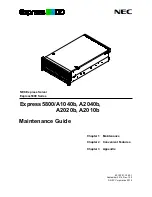
Option
Description
The options available are
Maximum data rate
,
10.4 GT/s
, and
9.6 GT/s
. This option is set to
Maximum data rate
by default.
Maximum data rate indicates that the BIOS runs the communication links at the maximum frequency supported by
the processors. You can also select specific frequencies that the processors support, which can vary.
For best performance, you should select
Maximum data rate
. Any reduction in the communication link frequency
affects the performance of non-local memory accesses and cache coherency traffic. In addition, it can slow access
to non-local I/O devices from a particular processor.
However, if power saving considerations outweigh performance, you might want to reduce the frequency of the
processor communication links. If you do this, you should localize memory and I/O accesses to the nearest NUMA
node to minimize the impact to system performance.
Virtualization
Technology
Enables or disables the virtualization technology for the processor. This option is set to
Enabled
by default.
Adjacent Cache
Line Prefetch
Optimizes the system for applications that need high utilization of sequential memory access. This option is set to
Enabled
by default. You can disable this option for applications that need high utilization of random memory
access.
Hardware
Prefetcher
Enables or disables the hardware prefetcher. This option is set to
Enabled
by default.
Software
Prefetcher
Enables or disables the software prefetcher. This option is set to
Enabled
by default.
DCU Streamer
Prefetcher
Enables or disables the Data Cache Unit (DCU) streamer prefetcher. This option is set to
Enabled
by default.
DCU IP Prefetcher
Enables or disables the Data Cache Unit (DCU) IP prefetcher. This option is set to
Enabled
by default.
Sub NUMA Cluster
Enables or disables the Sub NUMA Cluster. This option is set to
Disabled
by default.
UPI Prefetch
Enables you to get the memory read started early on DDR bus. The Ultra Path Interconnect (UPI) Rx path will
spawn the speculative memory read to Integrated Memory Controller (iMC) directly. This option is set to
Enabled
by default.
Logical Processor
Idling
Enables you to improve the energy efficiency of a system. It uses the operating system core parking algorithm and
parks some of the logical processors in the system which in turn allows the corresponding processor cores to
transition into a lower power idle state. This option can only be enabled if the operating system supports it. It is set
to
Disabled
by default.
Configurable TDP
Enables you to configure the TDP level. The available options are
Nominal
,
Level 1
, and
Level 2
. This option is set
to
Nominal
by default.
NOTE:
This option is only available on certain stock keeping units (SKUs) of the processors.
SST-Performance
Profile
Enables you to reconfigure the processor using Speed Select Technology.
x2APIC Mode
Enables or disables the x2APIC mode. This option is set to
Disabled
by default.
Number of Cores
per Processor
Controls the number of enabled cores in each processor. This option is set to
All
by default.
Processor Core
Speed
Specifies the maximum core frequency of the processor.
Processor Bus
Speed
Displays the bus speed of the processor.
Processor n
NOTE:
Depending on the number of processors, there might be up to two processors listed.
Pre-operating system management applications
45
















































